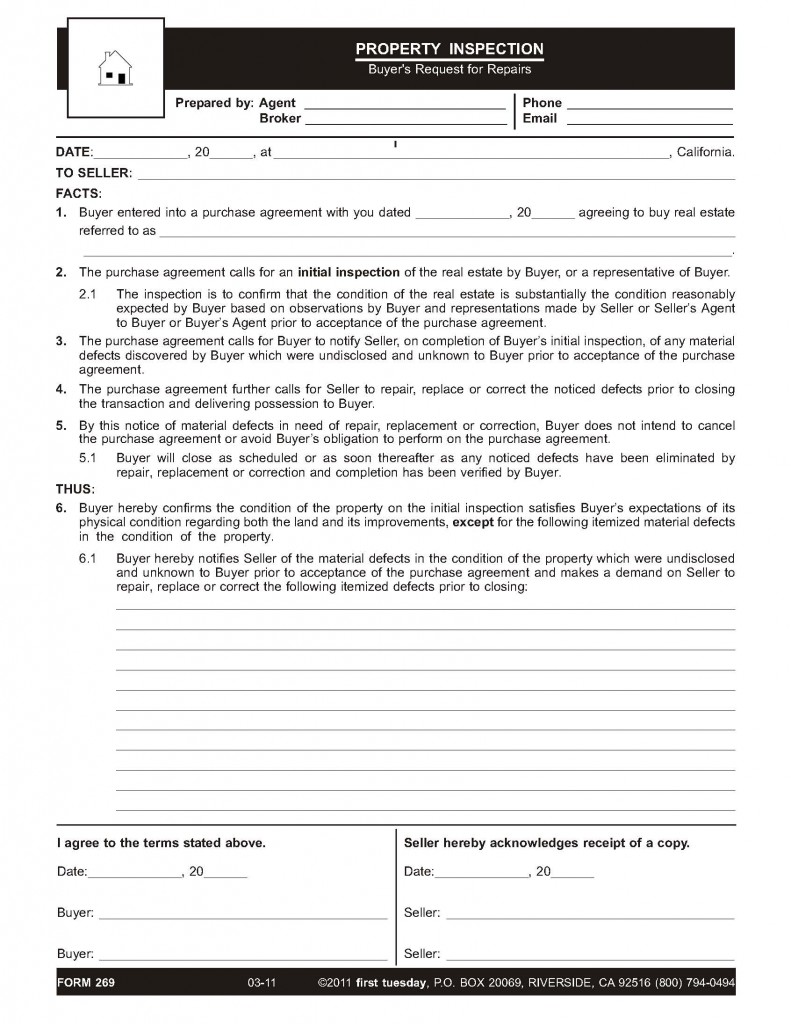Form-of-the-Week: Property Inspection – Buyer’s Request for Repairs – Form 269
The HIR for voluntary disclosure of property conditions
In the process of purchasing a home, the buyer’s due diligence includes conducting a home inspection.
Typically, the seller’s agent fails to order a home inspection report (HIR) for voluntarily disclosing property conditions under the affirmative duty they and the seller owe to the buyer before a purchase agreement is entered into.
Without an HIR delivered by the seller or seller’s agent, it becomes the buyer’s agent’s duty to guide and advise the buyer on the need for and selection of a home inspector, and assisting them by ordering an HIR on the property. [See first tuesday Form 130]
Related articles:
Contingency for further approval
All too often, the seller’s agent does not make an HIR available to a buyer or the buyer’s agent prior to the submission of the buyer’s purchase offer. Subsequently, the buyer’s agent includes a contingency provision in the purchase agreement regarding the further approval of the condition of the property.
Without an HIR, the buyer has no information on the condition of the property when setting the purchase price and terms they will offer, except what they see in their initial walk-through.
Contingency provisions in the purchase agreement call for:
- the seller to furnish an HIR prepared by an insured home inspector showing the land and improvements to be free of material defects [See first tuesday Form 150 §11.1(b)];
- the seller and the seller’s agent to prepare, sign and deliver a condition of property disclosure (TDS) [See first tuesday Form 150 §11.2]; and
- the buyer to inspect the property twice – once to confirm the condition of the property as disclosed when going under contract, and again before closing escrow to confirm maintenance has not been deferred and material defects discovered after entering into the purchase agreement have been corrected or eliminated. [See first tuesday 150 §11.4]
Consider a buyer who has no knowledge of physical defects in the property when their offer is accepted. The seller and the seller’s agent have a duty to deliver property disclosures before the acceptance of an offer. However, at the time of the acceptance, the TDS and other disclosures due from the seller have not yet been delivered to the buyer’s agent. [Calif. Civil Code §§1102, 2079]
The buyer, on their agent’s guidance, authorizes their agent to immediately order an HIR. On the agent’s receipt of the HIR, it is reviewed with the buyer.
The HIR lists numerous material defects observed during the home inspector’s physical inspection of the property’s condition. As a result, the buyer makes a written demand on the seller to cure the defects discovered by the home inspector. To substantiate the buyer’s demand, the buyer attaches a copy of the HIR and a contractor’s estimate of the cost to cure the defects. [See first tuesday Form 150 §11.4 and 269]
Due to the seller’s failure to disclose material defects before placing the buyer under contract, the seller is obligated to deliver the property to the buyer in the condition disclosed by the seller and the seller’s agent, and observed by the buyer at the time the buyer’s offer to purchase was accepted.
A later, untimely disclosure made in the TDS during escrow does not satisfy the mandate. Dilatory disclosure triggers statutory contingencies in the transaction.
Also, the seller’s and seller’s agent’s failure to disclose prior to acceptance is an omission of facts, called negative fraud, deceit or misrepresentation by omission.
The buyer’s remedies for deceit
If an HIR reveals material defects previously undisclosed and unknown to the buyer, the buyer may:
- make a demand on the seller to correct or eliminate the defects, and delay the close of escrow until the seller has either complied or agreed to an adjusted price [See first tuesday Form 269];
- refuse to close escrow for lack of seller compliance to the demand for corrections and enforce the agreement and its price correction provisions by specific performance; or
- close escrow and make a money demand on the seller for the difference between the purchase price set in the purchase agreement and the price adjusted for the undisclosed defects. [Jue v. Smiser (1994) 23 CA4th 312]
Buyer’s request for repairs
first tuesday’s Property Inspection – Buyer’s Request for Repairs is used by the buyer’s agent when the buyer makes a written demand on the seller to correct or eliminate the defects. [See first tuesday Form 269]
The request for repairs:
- notifies the seller of any material defects discovered by the buyer which were undisclosed and unknown to the buyer prior to acceptance of the purchase agreement;
- calls for the seller to repair, replace or correct the noticed defects prior to closing the transaction and delivering possession to the buyer;
- advises the seller that the buyer intends to fully perform their obligations under the purchase agreement and escrow instructions;
- confirms the buyer’s initial inspection of the property satisfies the buyer’s expectations of its physical condition, except for itemized material defects; and
- lists the defects which the buyer is making a demand on the seller to repair, replace or correct prior to closing. [See first tuesday Form 269]
Also, the seller who refuses to deliver the property in the condition disclosed and known to the buyer prior to acceptance fails to convey the property as agreed. Thus, the buyer is justified in refusing to close escrow until the seller corrects or compensates the buyer for the defects subsequently disclosed or discovered during escrow.
Nevertheless, when the buyer is made aware of property conditions affecting the property’s value at the time they enter into the purchase agreement, they have been given sufficient notice to investigate the consequences of such defects. Provided with this notice, the buyer has no grounds for later claiming a loss based on these conditions.















How do I request that the Seller make major repairs before going to closing? After inspection, there are electrical, plumbing and AC issues to be addressed as well as an undocumented addition of two bonus rooms.
My realtor did not notify me of an HIR, and suggested that since my Appraisal was so good a inspection, may not be necessary at all. 15 days after we took possession of our home we found moisture and mold in the master bedroom. I contacted the realtor immediately, whom I later realized was also the agent for the sellers, and was told there was nothing that could be done. I contacted my homeowners insurance company and was told we had groundwater. my elder mother has suffered disabling allergies from the mold my sons suffers from asthma as well as allergies. We’ve not used more than 1/2 the home since we’ve been here and April 18th, 2019 was the 1st anniversary we’ve spent here. Furthermore, it was never mentioned that drug dealers occupied the adjoining half-plex.
CAN SOMEONE HELP US PLEASE!?
Hi Meika! I hope the day finds you well. Have you been able to address this yet? It seems to me that you should be able to seek remedy due to gross misrepresentation and non-disclosure of material facts relating to the sale. I am not a legal professional, so you should seek one out. Where do you live? I may be able to recommend someone.